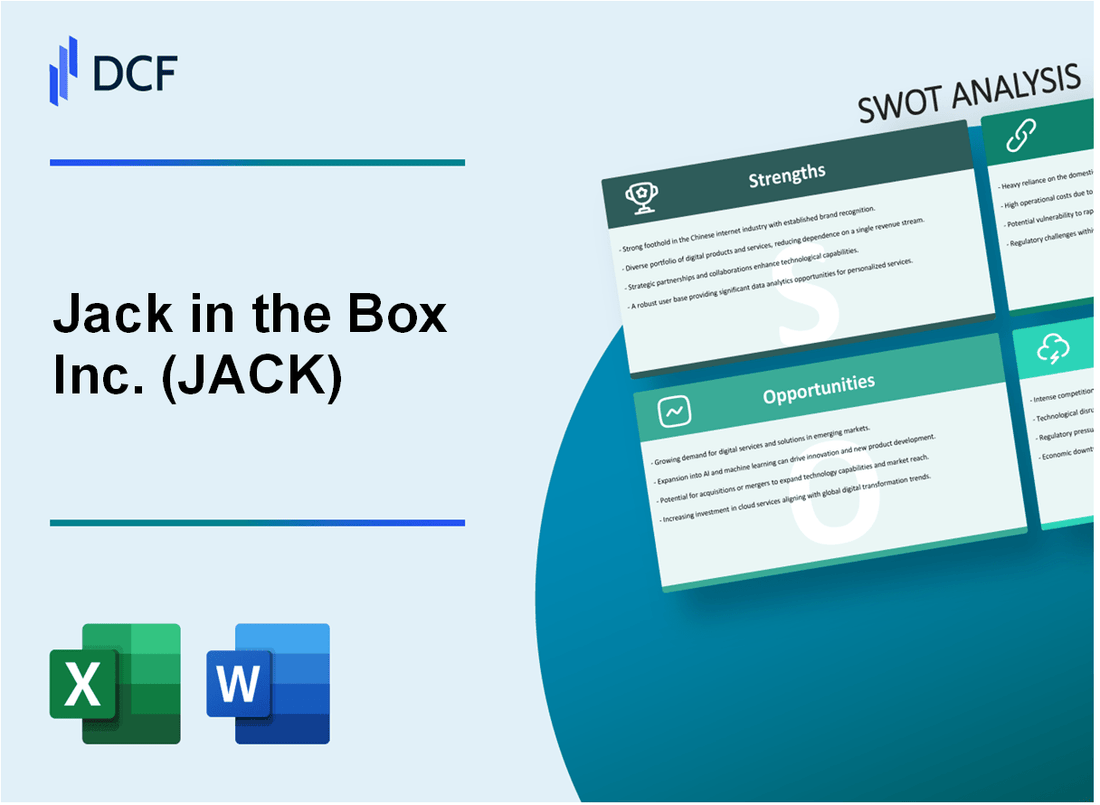
|
Jack in the Box Inc. (JACK): SWOT Analysis [Jan-2025 Updated] |

Fully Editable: Tailor To Your Needs In Excel Or Sheets
Professional Design: Trusted, Industry-Standard Templates
Investor-Approved Valuation Models
MAC/PC Compatible, Fully Unlocked
No Expertise Is Needed; Easy To Follow
Jack in the Box Inc. (JACK) Bundle
In the dynamic world of fast-food dining, Jack in the Box Inc. (JACK) stands out as a distinctive player, navigating the competitive landscape with strategic prowess and innovative approaches. This comprehensive SWOT analysis unveils the company's internal strengths and weaknesses, while exploring the external opportunities and threats that shape its business trajectory in 2024. From its unique menu offerings to digital transformation strategies, Jack in the Box reveals a compelling narrative of resilience, adaptation, and potential growth in the ever-evolving quick-service restaurant industry.
Jack in the Box Inc. (JACK) - SWOT Analysis: Strengths
Strong Brand Recognition in Fast-Food Quick-Service Restaurant Segment
Jack in the Box operates 2,206 restaurants as of 2023, primarily located in 15 states across the United States. The company generates annual revenue of $1.4 billion with a market capitalization of approximately $3.2 billion.
| Market Presence | Metrics |
|---|---|
| Total Restaurants | 2,206 |
| Annual Revenue | $1.4 billion |
| Market Capitalization | $3.2 billion |
Diverse Menu with Unique Offerings
Jack in the Box offers over 30 unique menu items, including signature tacos and distinctive breakfast selections.
- Signature Tacos: Selling approximately 554 million annually
- Breakfast Menu: Comprises 25% of total restaurant sales
- Unique Item Variety: Over 30 distinctive menu offerings
Robust Franchising Model
The company maintains a strong franchising strategy with consistent restaurant expansion.
| Franchising Metrics | Numbers |
|---|---|
| Franchise-Owned Restaurants | 1,328 |
| Company-Owned Restaurants | 878 |
| Annual Franchise Growth Rate | 2.5% |
Innovative Digital Ordering Platforms
Jack in the Box has invested significantly in digital technologies to enhance customer experience.
- Mobile App Downloads: 3.2 million active users
- Online Order Percentage: 18% of total sales
- Digital Loyalty Program Members: 2.7 million
Financial Stability
The company demonstrates consistent financial performance and growth.
| Financial Indicator | 2023 Data |
|---|---|
| Net Income | $172.3 million |
| Earnings Per Share | $6.82 |
| Revenue Growth | 5.7% |
Jack in the Box Inc. (JACK) - SWOT Analysis: Weaknesses
Limited Geographic Presence
Jack in the Box operates 2,200 restaurants, with approximately 95% located in 10 western U.S. states. Compared to McDonald's with 13,500+ locations and Burger King with 7,000+ restaurants, the company has significantly restricted market coverage.
| State Concentration | Percentage of Restaurants |
|---|---|
| California | 65% |
| Texas | 15% |
| Arizona | 8% |
| Other Western States | 12% |
Higher Menu Prices
Average meal prices at Jack in the Box are 15-20% higher than competitors like Wendy's and McDonald's. Typical combo meal prices range from $7.50 to $9.25.
Smaller Restaurant Footprint
The company maintains 2,200 total restaurant locations, compared to industry giants:
- McDonald's: 13,500+ locations
- Burger King: 7,000+ restaurants
- Wendy's: 5,900+ locations
Western United States Market Concentration
Jack in the Box has minimal presence outside western states, with 95% of restaurants concentrated in:
- California
- Texas
- Arizona
- Nevada
- Oregon
Limited Marketing Budget
Marketing expenditure for Jack in the Box is approximately 2.5% of total revenue, compared to industry averages of 4-5%. In 2023, marketing spend was estimated at $72 million against total revenue of $2.9 billion.
| Marketing Metric | Jack in the Box | Industry Average |
|---|---|---|
| Marketing Spend Percentage | 2.5% | 4-5% |
| Total Marketing Budget | $72 million | N/A |
| Total Revenue | $2.9 billion | N/A |
Jack in the Box Inc. (JACK) - SWOT Analysis: Opportunities
Potential Expansion into Emerging Regional Markets
Jack in the Box currently operates 2,200 restaurants, primarily concentrated in 15 states across the Western United States. Potential regional expansion markets include:
| Target Region | Market Potential | Estimated New Restaurant Opportunities |
|---|---|---|
| Texas | $4.2 billion fast-food market | 350-400 potential new locations |
| Southeast Region | $3.8 billion fast-food market | 250-300 potential new locations |
Digital Ordering and Contactless Food Delivery
Digital ordering market growth statistics:
- Online food delivery market projected to reach $154.34 billion by 2027
- Digital ordering revenue expected to grow at 10.5% CAGR
- Mobile app downloads increased 54% in 2022-2023
Unique Menu Innovations
Consumer preferences for innovative menu items:
| Menu Innovation Category | Consumer Interest Percentage |
|---|---|
| Fusion Cuisine | 68% |
| Global Flavor Profiles | 62% |
| Limited-Time Offerings | 55% |
International Market Expansion
Potential international markets with favorable fast-food landscape:
- Mexico: $25.6 billion fast-food market
- Canada: $33.4 billion fast-food market
- Middle East: Projected $36.7 billion fast-food market by 2025
Plant-Based and Health-Conscious Menu Options
Plant-based market growth projections:
| Market Segment | 2023 Value | 2030 Projected Value | CAGR |
|---|---|---|---|
| Plant-Based Food Market | $42.6 billion | $79.8 billion | 9.2% |
Jack in the Box Inc. (JACK) - SWOT Analysis: Threats
Intense Competition in Fast-Food and Quick-Service Restaurant Sector
The fast-food market in the United States was valued at $322.18 billion in 2022, with intense competition from major players.
| Competitor | Market Share | Annual Revenue |
|---|---|---|
| McDonald's | 37.4% | $23.18 billion (2022) |
| Burger King | 14.6% | $10.2 billion (2022) |
| Wendy's | 9.3% | $2.1 billion (2022) |
Rising Food and Labor Costs Impacting Profit Margins
Food cost inflation reached 11.4% in 2022, significantly impacting restaurant profitability.
- Beef prices increased by 14.3% in 2022
- Minimum wage increases in multiple states
- Average restaurant labor costs rose 6.2% in 2022
Changing Consumer Dietary Preferences and Health Trends
Plant-based meat alternatives market projected to reach $85.06 billion by 2030.
| Dietary Trend | Consumer Adoption Rate |
|---|---|
| Plant-based diets | 39% of Americans |
| Low-calorie options | 62% of consumers |
Economic Uncertainties Affecting Consumer Dining Spending
Consumer spending on restaurant dining decreased by 3.4% in 2022 due to economic pressures.
- Inflation rate: 6.5% in 2022
- Consumer confidence index: 64.7 in December 2022
- Average household discretionary spending reduced by 5.2%
Potential Supply Chain Disruptions and Ingredient Cost Volatility
Global supply chain disruptions increased logistics costs by 22% in 2022.
| Supply Chain Factor | Impact Percentage |
|---|---|
| Transportation costs | 22% increase |
| Ingredient price volatility | 15.7% fluctuation |
| Procurement challenges | 18.3% disruption rate |
Disclaimer
All information, articles, and product details provided on this website are for general informational and educational purposes only. We do not claim any ownership over, nor do we intend to infringe upon, any trademarks, copyrights, logos, brand names, or other intellectual property mentioned or depicted on this site. Such intellectual property remains the property of its respective owners, and any references here are made solely for identification or informational purposes, without implying any affiliation, endorsement, or partnership.
We make no representations or warranties, express or implied, regarding the accuracy, completeness, or suitability of any content or products presented. Nothing on this website should be construed as legal, tax, investment, financial, medical, or other professional advice. In addition, no part of this site—including articles or product references—constitutes a solicitation, recommendation, endorsement, advertisement, or offer to buy or sell any securities, franchises, or other financial instruments, particularly in jurisdictions where such activity would be unlawful.
All content is of a general nature and may not address the specific circumstances of any individual or entity. It is not a substitute for professional advice or services. Any actions you take based on the information provided here are strictly at your own risk. You accept full responsibility for any decisions or outcomes arising from your use of this website and agree to release us from any liability in connection with your use of, or reliance upon, the content or products found herein.
